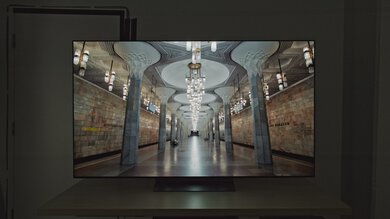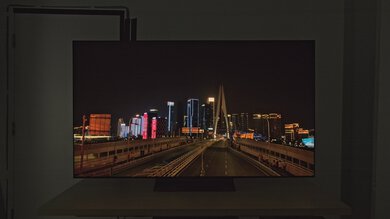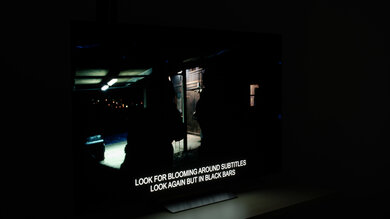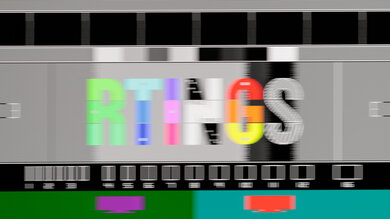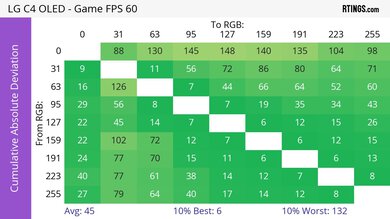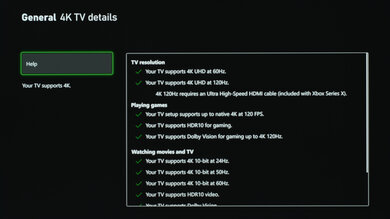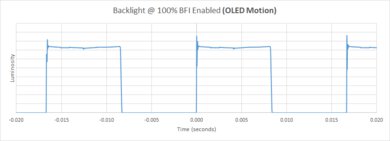The LG C4 OLED is the 2024 iteration in LG's popular C Series lineup and replaces 2023's LG C3 OLED. It sits above the LG B4 OLED and below the LG G4 OLED. It uses LG's new α9 AI Processor Gen7, designed to provide better overall image processing than its predecessors. New to the C4 is the ability to game up to 144Hz, an upgrade from the maximum 120Hz on the models from the past few years. It also adds 'Filmmaker Mode' as a picture setting for Dolby Vision, designed to provide an accurate image without needing to tweak any settings. The TV uses the 2024 version of LG's webOS, and it has 40W 2.2 channel speakers built-in that can be virtually up-mixed to 9.1.2 using the α9 AI Sound Pro feature. It's available in six sizes: 42-inch, 48-inch, 55-inch, 65-inch, 77-inch, and 83-inch. We tested the 65-inch model.
Our Verdict
The LG C4 is impressive for mixed usage. Unfortunately, while it is bright enough to overcome glare in a bright room, it struggles to reduce the intensity of direct reflections, making glare more distracting than you'd like. However, it's well-suited for use in reference conditions like a home theater since it has vibrant colors, perfect blacks, and incredible accuracy. It's bright enough in HDR to display impactful highlights in HDR content, especially when contrasted with the TV's perfect black levels, delivering a very impactful HDR experience, although unfortunately, it's noticeably dimmer in Game Optimizer. Otherwise, the TV is a solid option for gaming, thanks to its modern gaming features, 144Hz support at 4k, and sharp motion. Finally, it's a solid option for watching content with a group of friends due to its wide viewing angle.
Near-infinite contrast ratio for perfect blacks with no blooming around bright highlights.
Incredibly wide viewing angle for a consistent image from the sides.
Colors are vibrant, lifelike, bright, and accurate.
Bright enough in HDR to deliver an impactful HDR experience.
Direct reflections are distracting.
Lacks the SDR brightness needed to fully overcome glare in a bright room.
Loses a lot of its HDR brightness in Game Optimizer mode.
The LG C4 is a great choice for a home theater setup. As an OLED TV, it delivers perfect black levels without any blooming. Its HDR brightness is sufficient for highlights to stand out, especially against those perfect black levels. It reproduces vivid, lifelike colors with minimal banding, resulting in impactful HDR content. In addition, it preserves the creator's intended brightness for HDR, so you won't experience an overly bright or overly dim image. It also boasts impressive upscaling capabilities, effectively smoothing out artifacts in heavily compressed online media. Unfortunately, because of the TV's near-instantaneous response time, movies and TV shows can exhibit noticeable stutter.
Near-infinite contrast ratio for perfect blacks with no blooming around bright highlights.
Colors are vibrant, lifelike, bright, and accurate.
Does a very good job upscaling and cleaning up low-quality content.
Bright enough in HDR to deliver an impactful HDR experience.
Noticeable stutter due to the TV's fast response time.
The LG C4 performs reasonably well in brightly lit rooms. Its SDR brightness is sufficient to handle some glare, but it struggles with direct reflections, making it less ideal if you have wall lights, lamps, or a window facing the screen. However, blacks remain deep, and colors stay well-saturated under ambient lighting, so you don't lose much picture quality even with the lights on.
Colors are vibrant, lifelike, bright, and accurate.
Blacks remain deep and colors stay vibrant in a room with ambient lighting.
Direct reflections are distracting.
Lacks the SDR brightness needed to fully overcome glare in a bright room.
The LG C4 is a decent choice for watching sports. It's sufficiently bright in SDR to handle glare in well-lit rooms, although it struggles to mitigate reflections from direct light sources, such as lamps or windows directly opposite the screen. Thanks to its excellent screen uniformity, there's minimal dirty screen effect in the center, and motion appears smooth due to its fast response time. It excels at upscaling both SD and HD broadcasts and streams, reducing artifacts even during heavily compressed games. Colors are vivid and accurate, ensuring team jerseys look as they should. Plus, its wide viewing angle ensures the picture remains consistent when viewed from the sides—a convenient feature for watching the game with a group of friends.
Incredibly wide viewing angle for a consistent image from the sides.
Nearly instantaneous pixel transitions for no noticeable blur behind fast motion.
Colors are vibrant, lifelike, bright, and accurate.
Does a very good job upscaling and cleaning up low-quality content.
Direct reflections are distracting.
Lacks the SDR brightness needed to fully overcome glare in a bright room.
The LG C4 is amazing for playing video games. The TV has HDMI 2.1 bandwidth on all four of its ports and supports up to 4k @ 144Hz with VRR, so it's a fantastic choice to pair with modern consoles or modern gaming PCs. The TV's exceptionally low input lag delivers a responsive gaming experience, and there's no noticeable blur behind fast motion due to the TV's nearly instantaneous response time. Unfortunately, it is noticeably dimmer in HDR when in Game Optimizer mode, but it makes up for it with its perfect black levels and impressive colors, still providing a very impactful HDR gaming experience.
Nearly instantaneous pixel transitions for no noticeable blur behind fast motion.
Colors are vibrant, lifelike, bright, and accurate.
Incredibly low input lag for a very responsive experience.
Loses a lot of its HDR brightness in Game Optimizer mode.
The LG C4 has decent brightness overall. Its SDR brightness is okay; enough to overcome some glare in a well-lit room, but you'd still wish it was brighter when watched in very bright contexts. In HDR, it's bright enough for highlights to pop, especially when set against the TV's perfect black levels, delivering an impressive HDR experience.
Bright enough in HDR to deliver an impactful HDR experience.
Lacks the SDR brightness needed to fully overcome glare in a bright room.
Loses a lot of its HDR brightness in Game Optimizer mode.
Since the LG C4 is an OLED, it has perfect black levels. Blacks are deep and inky when viewed in a dark room, with no blooming around bright highlights.
Near-infinite contrast ratio for perfect blacks with no blooming around bright highlights.
The LG C4 has impressive colors. It has solid color volume overall, so colors are vibrant and lifelike, but it does struggle more with displaying very light colors. Fortunately, this is an amazingly accurate TV in both SDR and HDR, and it respects the content creator's intent without needing calibration.
Colors are vibrant, lifelike, bright, and accurate.
Note:We're in the process of improving our tests related to image processing, but this score should give you a general idea of how a TV performs overall with its image processing capabilities.
The LG C4 has great image processing overall. The brightness of HDR content is very accurate, so it stays true to the content creator's intent, and color gradients are smooth with minimal banding. It does a very good job upscaling low-resolution content so it doesn't look too soft. Its low-quality content smoothing reduces the number of artifacts you see in low-bitrate content, but it doesn't eliminate them completely.
Does a very good job upscaling and cleaning up low-quality content.
Exceptional HDR brightness accuracy.
The LG C4 has outstanding responsiveness while in Game Optimizer. The TV's input lag is very low across the board, and it supports VRR for a nearly tear-free experience, so gaming feels responsive. It supports a 144Hz refresh rate at 4k, a great feature for PC gamers with powerful rigs. It also has nearly instantaneous pixel transitions, which makes fast motion very clear.
Nearly instantaneous pixel transitions for no noticeable blur behind fast motion.
Incredibly low input lag for a very responsive experience.
We're in the process of fixing the way we evaluate a TV's overall motion handling. This section is currently broken, and the score isn't indicative of how well a TV handles motion overall.
Performance Usages
Changelog
-
Updated May 13, 2025:
Mentioned the newly reviewed LG C5 OLED in the SDR Brightness section.
- Updated May 08, 2025: Converted to Test Bench 2.0.1. We did this to fix an issue with our scoring in the Supported Resolutions section, since TVs with a refresh rate higher than 144Hz were being penalized for not supporting 144Hz.
-
Updated Mar 26, 2025:
We wrote text for the new tests and rewrote text throughout the review after updating pre-existing tests and scores for Test Bench 2.0.
- Updated Mar 26, 2025: We converted the review to Test Bench 2.0. With this new methodology, we've added new tests to expand the scope of our testing, adjusted our scoring to better align with current market conditions, and added performance usages that group related tests together to give more insight into specific aspects of a TV's performance. You can find a full list of changes in the TV 2.0 changelog.
Check Price
Differences Between Sizes And Variants
We bought and tested the 65-inch LG C4 (OLED65C4); these results are also valid for the 55, 77, and 83-inch sizes. The 42-inch and 48-inch sizes don't have LG's Brightness Booster technology, so they don't get as bright as the bigger models do. Note that the last three letters in the model number (PUA in this case) vary between retailers and individual regions, but there's no difference in performance. The Costco/Sam's Club variant carries the suffix 'AUA,' supports Wi-Fi 6E (the PUA variant has Wi-fi 5), and comes with store-specific perks, like extended warranties.
| Size | US Model (Wi-Fi 5) | Costco Variant (Wi-Fi 6E) | Brightness Booster |
|---|---|---|---|
| 42" | OLED42C4PUA | OLED42C4AUA | - |
| 48" | OLED48C4PUA | OLED48C4AUA | - |
| 55" | OLED55C4PUA | OLED55C4AUA | Yes |
| 65" | OLED65C4PUA | OLED65C4AUA | Yes |
| 77" | OLED77C4PUA | OLED77C4AUA | Yes |
| 83" | OLED83C4PUA | OLED83C4AUA | Yes |
Our unit was manufactured in March 2024.
Popular TV Comparisons
The LG C4 OLED is an impressive TV that further cements the C Series lineup as some of the best WOLEDs on the market. Still, unless you need the 144Hz refresh rate or its other small upgrades, you're better off getting the cheaper LG B4 OLED; it's a bit dimmer in HDR, and it doesn't have a 144Hz refresh rate, but it doesn't lose any of its HDR brightness in Game Optimizer. Also, consider the Samsung S90D OLED, as it's a bit brighter than the C4, doesn't lose any of its brightness in Game Optimizer, and is much more colorful. Unfortunately, the Samsung doesn't support Dolby Vision, so you're missing out on that by going with that model over the LGs.
For more options, check out our recommendations for the best OLED TVs, the best gaming TVs, and the best TVs for watching movies.
The LG C4 OLED is better than the LG B4 OLED for the most part. The C4 has better reflection handling and slightly better SDR peak brightness, so it handles a bit more glare in a bright room, and it has better low-quality content smoothing. The C4 also gets brighter in HDR in most picture modes, making highlights pop more in HDR content. However, the two TVs have very similar HDR brightness while using the Game Optimizer picture mode.
While the two TVs are very similar, the LG C4 OLED is better than the LG B5 OLED. The C4 is brighter in HDR and SDR, handles ambient reflections better, and is capable of gaming at up to 4k @ 144Hz on all ports; the B5 is limited to 120Hz. Otherwise both TVs have the same set of features, although the B5 supports the 6Ghz Wi-Fi band, which the C4 doesn't have.
The Samsung S90D OLED is mostly better than the LG C4 OLED. The Samsung gets brighter in HDR, so bright highlights stand out more on it, and it maintains its HDR brightness better while in Game Mode. The Samsung TV also has a wider color gamut, better color volume, and better HDR gradient handling, so colors in HDR are more vibrant, lifelike, brighter, and have less banding. The Samsung has a wider viewing angle, and the image doesn't have a green tint that worsens as you move off-center, so it's the better choice for watching TV in a group setting. However, the LG supports Dolby Vision and DTS audio formats, so it's the better option for those looking to get the most out of their physical media.
The LG G4 OLED is better than the LG C4 OLED. The G4 gets brighter overall, so it overcomes more glare in a bright room while watching SDR content, and highlights pop more in HDR content. The G4 also maintains its HDR brightness much better while in 'Game Optimizer.' On top of that, the G4 is more accurate before calibration and has less banding in colors.

We buy and test dozens of TVs yearly, taking an objective, data-driven approach to deliver results you can trust. Our testing process is complex, with hundreds of individual tests that take over a week to complete. Most of our tests are done with specially designed test patterns that mimic real content, but we also use the same sources you have at home to ensure our results match the real-world experience. We use two main tools for our testing: a Colorimetry Research CR-100 colorimeter and a CR-250 spectroradiometer.
Test Results

The LG C4 OLED has good HDR brightness. It gets bright enough for most highlights to pop, but it's not bright enough to properly display very bright highlights. Still, it delivers an impactful HDR experience. Unfortunately, large bright scenes are significantly dimmer than smaller, specular highlights due to its aggressive Automatic Brightness Limiter (ABL).
These measurements are after calibrating the HDR white point with the following settings:
- HDR Picture Mode: Cinema
- OLED Pixel Brightness: 100
- Contrast: 100
- Auto Dynamic Contrast: Off
- Dynamic Tone Mapping: Off
- Expression Enhancer: Off
- Peak Brightness: High
Note that the 42-inch and 48-inch models don't have LG's Brightness Booster technology, so they don't get as bright as the bigger models do.
The LG C4 OLED is noticeably dimmer while in Game Optimizer. It's still bright enough to provide an impactful HDR gaming experience, but you notice the drop in brightness compared to the TV's other picture modes.
These measurements are after calibrating the HDR white point with the following settings:
- HDR Picture Mode: Game Optimizer
- OLED Pixel Brightness: 100
- Contrast: 100
- Auto Dynamic Contrast: Off
- Dynamic Tone Mapping: HGiG
- Expression Enhancer: Off
- Peak Brightness: High
The LG C4 has okay SDR brightness. It gets bright enough to handle glare in a bright room, although it's better suited for a moderately lit room. Fortunately, the TV's Automatic Brightness Limiter isn't aggressive in SDR, so you don't have to deal with the screen dimming considerably when large areas of brightness are present.
These measurements are after calibration with the following settings:
- Picture Mode: Dark Space, night
- OLED Pixel Light: 100
- Peak Brightness: High
- Color Temperature: Warm 50
If you like what this TV offers but wish it were brighter, take a look at the newer LG C5 OLED.
The LG C4 is an OLED and has no backlight, so its self-lit pixels give it the same performance as a TV with perfect local dimming and no zone transitions. We still film the zone transition video on the TV so you can see how it compares to a TV with local dimming.
The LG C4 has very good SDR color volume. Its coverage of the DCI-P3 color space is outstanding, and it covers the majority of that space, only struggling a bit with some very light colors. Unfortunately, its coverage of the wider BT.2020 color space is more limited.
| Volume ΔE³ | DCI-P3 Coverage |
BT.2020 Coverage |
|---|---|---|
| L10 | 98.49% | 66.54% |
| L20 | 98.39% | 66.82% |
| L30 | 98.26% | 67.75% |
| L40 | 97.76% | 69.37% |
| L50 | 97.25% | 70.00% |
| L60 | 95.22% | 67.96% |
| L70 | 91.24% | 58.81% |
| L80 | 91.38% | 56.44% |
| L90 | 89.07% | 54.83% |
| L100 | 78.48% | 51.26% |
| Total | 93.69% | 62.82% |
The TV has good color volume. It displays dark, saturated colors very well, and its ability to display bright whites is outstanding. It doesn't display other colors as brightly as it does whites, but it's still enough to display bright and vibrant colors.
With the TV set to Game Optimizer, there's a visible decrease in color luminance, and you can see the measurements below.
- White Luminance: 991 cd/m²
- Red Luminance: 98 cd/m²
- Green Luminance: 310 cd/m²
- Blue Luminance: 32 cd/m²
- Cyan Luminance: 340 cd/m²
- Magenta Luminance: 127 cd/m²
- Yellow Luminance: 409 cd/m²
The LG C4 has excellent pre-calibration accuracy. Its white balance is amazing, with just a bit too much red in all shades of gray. Gamma is very close to our target of 2.2, but bright scenes are a bit too bright. Color temperature is superb, but it's warmer than our target of 6500K, and color accuracy is outstanding, with only very minor inaccuracies in whites, lighter yellows, and lighter cyans.
The TV has exceptional accuracy after calibration to the D65 white point. The white balance and gamma are now essentially perfect. Color accuracy is even better than before, with no noticeable inaccuracies, and color temperature is incredibly close to our target of 6500K.
You can see our full calibration settings.
The LG C4 has excellent accuracy in HDR before calibration. Its white balance is fantastic, but there's not enough blue and too much red in some brighter grays, which makes its color temperature slightly warmer than 6500K. The TV's color accuracy is excellent, but there are some mapping errors throughout, most notably in some reds and magentas.
The TV has incredible accuracy in HDR after calibration. Its white balance is a bit better now, and its color temperature is nearly perfect. Colors are also more accurate than before, but there's still some very minor mapping errors, and reds are a bit undersaturated.
The LG C4 has excellent PQ EOTF tracking. Some darker shadows and mid-tones are a bit brighter than intended, but the TV tracks the curve very closely. With content mastered at 600 or 1000 nits, there's a very small roll-off to preserve some detail in highlights. With content mastered at 4000 nits, there's a much more gradual roll-off to preserve detail in very bright highlights.
The LG C4 is impressive when upscaling low-resolution content like DVDs or lower-resolution streams. Details are clear enough, but very fine details are hard to make out.
Sharpness processing was calibrated with no over-sharpening for low-resolution content with the following settings:
- Sharpness: 16
- Super Resolution: Off
The TV has very good HDR native gradient handling. There's some noticeable banding in bright grays, dark grays, and bright greens, but all other colors have minimal banding or no banding at all.
The LG C4 has exceptionally low input lag when set to Game Optimizer with 'Prevent Input Delay' set to 'Boost,' resulting in a very responsive gaming experience with very little delay between the actions on your controller and what happens on screen. For chroma 4:4:4 to work properly, you must set the input label to 'PC,' or the '4:4:4 Passthrough' setting must be enabled.
If you're a retro gamer, you can see the input lag results in 4:3 @ 60Hz below.
- 640x480: 27.2 ms
- 800x600: 33.8 ms
- 1024x768: 26.8 ms
The LG C4 supports all common formats. It displays chroma 4:4:4 properly, which is important for clear text from a PC.
There are two settings you can use to passthrough proper chroma 4:4:4. The first is to change the input label to 'PC.' The second is to enable the '4:4:4 Passthrough' setting in the 'HDMI Settings' menu. Both of these options work the same and lock you out from using the 'Peak Brightness,' 'Noise Reduction,' 'MPEG Noise Reduction,' 'Smooth Gradation,' and 'Real Cinema' settings.
The TV supports FreeSync and HDMI Forum VRR and is certified as G-SYNC compatible, ensuring a nearly tear-free gaming experience from any VRR-enabled source.
The TV's CAD at 60Hz is fantastic. Most transitions from one RGB level to another are nearly instantaneous, but it's slightly slower when transitioning from blacks. There's also still some noticeable persistence blur due to the nature of a 60Hz refresh rate.
The TV is fully compatible with everything the PS5 offers, like 1440p @ 120Hz and 4k @ 120Hz, as well as HDMI Forum VRR. It also supports Auto Low Latency Mode, so you don't have to worry about switching to Game Optimizer to get the lowest input lag.
The TV is fully compatible with everything the Xbox Series X|S offers, including 1440p @ 120Hz, 4k @ 120Hz, HDMI Forum VRR, FreeSync Premium Pro, and Dolby Vision gaming. It also supports Auto Low Latency Mode, so you don't have to worry about switching to Game Optimizer to get the lowest input lag.
Unfortunately, due to the TV's nearly instantaneous pixel response time, there's stutter with low frame rate content, which is most noticeable during slow panning shots.
The TV removes judder when watching 24p movies or TV shows when the Real Cinema setting is enabled, even from sources that can only send a 60Hz signal, like a cable box. Unfortunately, movies and TV shows aren't judder-free when BFI is enabled because the BFI feature only flickers at 60Hz.
The LG C4 doesn't have a traditional backlight and doesn't use pulse-width modulation (PWM) to dim each pixel, but it's not completely flicker-free. There's a slight dip in brightness that corresponds to the TV's refresh rate. This differs from the PWM flicker on TVs with LED backlights and occurs on every OLED we've tested. It's not noticeable, and most people won't be bothered by this, but it can still bother people who are extra sensitive to flicker.
The TV has an optional black frame insertion (BFI) feature that reduces the appearance of persistence blur caused by the TV's nearly instantaneous response time. It can only insert black frames at a 60Hz refresh rate.
The TV has an optional motion interpolation feature to help improve the appearance of motion. It works well with slower scenes but struggles with fast-moving action, so there's noticeable haloing and artifacts present in busier scenes, especially if you use the settings too aggressively.
The LG C4's direct reflection handling is alright. It reduces the intensity of direct reflections a little, but glare from lamps or windows opposite the screen is still distracting.
The LG C4 OLED has exceptional black levels in a bright room. Black levels are barely raised in a room with ambient lighting, and they remain deep and punchy.
The TV has decent perceived color volume in ambient lighting. Colors shown at all levels of luminance are still vibrant and saturated in a bright room since they only lose a small amount of saturation from ambient sources of light. That said, high-luminance colors do lose some saturation in very bright contexts, although it's hard to notice unless you look closely.
Like all OLED TVs, the LG C4 has a fantastic wide viewing angle. This makes it a great choice for a wide seating arrangement, as the image doesn't wash out or degrade when viewed at an angle.
There's a noticeable green tint on the C4 we bought and tested. It's a widespread issue that impacts almost all LG OLED panels but varies widely from unit to unit. LG Electronics has confirmed to us that our unit is about as bad as it gets, and anything worse wouldn't pass LG's quality control checks. Although it varies between units, most people won't see this issue on their TV. This issue also isn't new or exclusive to the C4, as it's been an issue on LG TVs for a few years now.
The TV uses a WOLED panel with a RWBG pixel structure where all four pixels are never lit at the same time. Due to its subpixel layout, it has minor issues with displaying text on Windows since ClearType isn't well optimized to non-RGB subpixel layouts, but most users won't be bothered by this.
The white subpixel does an excellent job helping the TV display bright whites, but it dilutes the color purity of greens and reds.
The LG C4 TV supports the full 48Gbps bandwidth of HDMI 2.1 on all four HDMI ports. This allows you to take full advantage of multiple high-bandwidth devices, like if you own both current-gen consoles and a high-end gaming PC.
The TV supports many audio formats, including DTS audio formats, which is great if you like to watch DVDs or Blu-rays, as they often use DTS for their main audio tracks.
The TV has a very sleek and modern design. It's very similar to 2023's LG C3 OLED, but the back has a unique stone-like finish. The TV's bezels are incredibly thin, so you barely see them while watching.
The included stand on the 65-inch LG C4 is identical to the stand on 2023's LG C3 OLED. The TV wobbles a bit when pushed on, but it quickly recovers, so this doesn't cause any issues. The stand lifts the screen about 2.7 inches above the table, so most soundbars fit underneath without blocking the screen. The 83-inch model uses a bigger stand, and the 42-inch model uses two wide-spread feet instead of a stand.
Footprint of the 65-inch stand: 18.5" x 9.0"
The back of the TV is made from plastic that is grainy to the touch and has a unique stone-like finish that really separates it from other TVs. Outside of that, the back is the same as the LG C3 OLED, with a large plastic central panel that houses the inputs. The inputs face the right which makes them easy to access if you have the TV on the stand, but they're still hard to reach when the TV is wall-mounted.
The back of the TV has clips that you can funnel cables through, and then they can be put through the clip on the stand to help with cable management.
The TV runs the 2024 version of LG's proprietary smart interface, webOS. The interface is fast and easy to use, and it supports user profiles, so you can customize the home page for different users. LG promises at least four years of webOS updates on their TVs, and the C4 is expected to receive webOS 25 towards the end of 2025.
The TV has a bug that causes the occasional black screen when changing resolutions and refresh rates frequently in a short period. The only fix for this is to unplug and re-plug the TV, but this is unlikely to happen with real-world usage.
There are two settings in the 'Home Settings' menu, namely the 'Home Promotion' and 'Content Recommendation' settings. These settings remove the top banner ads and suggested content from the home screen. This gives your home screen a clean look, but there's no way to remove ads from the apps page.
The LG C4 OLED TV has the same Magic Remote as the LG C3 OLED. You can use the remote as a pointer or use the traditional buttons to control the TV. The TV also supports hands-free voice control through microphones on the unit itself. You can use your voice to change inputs, open apps, search for content, and ask for the weather and time.
The TV has an alright frequency response. The TV speakers produce a small amount of bass, but it's not enough to have much impact on the viewer. The sound profile is well-balanced enough that the dialogue is clear, but the TV doesn't get very loud, and there are compression and pumping artifacts at maximum volume.




